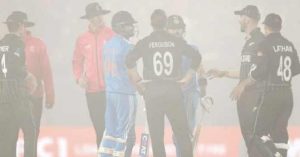Rain or inadequate light has more than once caused a cricket match to be abandoned. If there is a reserve day, sometimes even rain has forced games to be postponed and resumed the following day.
India experienced this twice in ICC and ACC competitions. They played New Zealand in their 2019 World Cup semifinal over two days. Rain prevented play after the Black Caps’ innings, so India had to bat the following day after New Zealand finished their innings on the first day. This was not good news for India, as Kiwi pacers went on to crush them.
India and Pakistan recently engaged in a two-day Asia Cup 2023 match in Colombo, with the Men in Blue thoroughly dominating Pakistan in a one-sided contest. There have been many more strange explanations for having to end a match in the middle or not play it at all.
5 unusual reasons cricket match was stopped:
5. Too much sunlight:

Photo Source: Twitter
You did indeed read it correctly. Play was halted during India’s innings in the 2019 Napier ODI between New Zealand and India due to excessive sunlight. Because of its architecture, McLean Park, the site of this match, is well-known for this kind of thing. The sun sets at the venue at approximately 7 PM, creating an unfavourable angle that shines sunlight directly into the batter’s eyes.
The ground’s pitches are oriented east-west, which is why this occurs at McLean Park. The pitch alignment on most cricket grounds is north-south. Playing cricket becomes risky and dangerous for the batter’s vision as a result. The same problem caused a T20I between Bangladesh and New Zealand in 2017 to be postponed.
4. Desert Storm:

Photo Source: Twitter
India and Australia squared off on April 22, 1998, in Sharjah during the Coca-Cola Trophy tri-series, in one of the best ODI games ever. Australians chose to bat first and amassed a massive 284 for 7 in their 50 overs. In the ninth over, with the score at 38, India, chasing 285 runs, lost Saurav Ganguly for 17. The innings were steadied by Sachin Tendulkar and wicketkeeper-batsman Nayan Mongia until the 22nd over of play saw Mongia dismissed for 35.
Subsequently, an “Arid storm” caused a nearly 30-minute interruption to the Indian innings. Both Indian batters had to run back inside the pavilion to save themselves because there was so much sand there. In 46 overs, India reached 276. With an unprecedented 141-run knock, Sachin Tendulkar led India to a historic victory and the championship match.
3. Solar Eclipse:

In February 1980, India and England were playing a Test match in Mumbai to commemorate the BCCI’s golden jubilee. Since England defeated India by 10 wickets, this Test is also known as Ian Botham’s Test because he amassed a century and claimed 13 wickets. On what should have been the second day of the Test instead of the fourth, the team had a peculiar rest day.
A total solar eclipse that was due to happen on February 16 was the reason. The BCCI wished to prevent eye damage from staring at the sun from the 50,000 spectators. The solar eclipse would be the first total eclipse of the 20th century to occur in the nation. In Mumbai, there was an 87% eclipse, while in southern India, there was a full eclipse.
2. Unplayable pitch:

The fifth One-Day International (ODI) between India and Sri Lanka took place at the Arun Jaitley (previously Feroz Shah Kotla) stadium in Delhi in 2009. India had a 3-1 lead and had already won the series. On an unpredictable pitch at Kotla, MS Dhoni won the toss and elected to bowl first. However, when Sri Lanka batted, the suspicions of something more sinister from the pitch came to pass.
Due to an unsafe pitch in Delhi with uneven bounce, Sri Lankan batters were battered and bruised. On a Kotla pitch where the bounce – from similar lengths – changed from shin to shoulder in as few as three deliveries, Sri Lanka had considerable cause for celebration that they managed to escape with only two hits on the body that needed attention. Because of the “extremely variable bounce and too dangerous for further play” of the pitch, the match was called off after 23.3 overs by the officials.
1. Fog:

During India vs. New Zealand ODI World Cup 2023 match, nature interrupted a cricket match for the first time in recent memory. This match took place in Dharamsala at the HPCA stadium. After losing the toss, New Zealand chose to bat first and scored 273 runs. They put a lot of effort into defending the total, especially after India took the lead thanks to Rohit Sharma’s fast 46 runs in the powerplay. But as thick fog descended on the playing surface, the match had to be abandoned for several minutes, with India at 100/2 in 15.2 overs.
The players on both sides found it difficult to focus on the balls due to the fogging of the atmosphere. The umpires decided to halt play until things were resolved in such a scenario. When play soon resumed, India had defeated New Zealand by 4 wickets, led by Virat Kohli’s impressive 95 runs.
So, this was all about the unusual and rare reasons why a cricket match was stopped. Also read, ODI Cricket World Cup: Top 5 Fastest Centuries in History.

